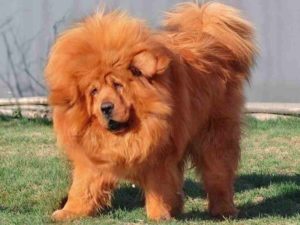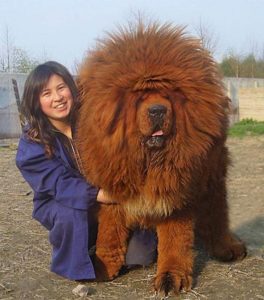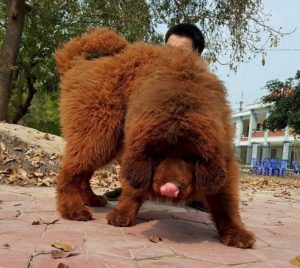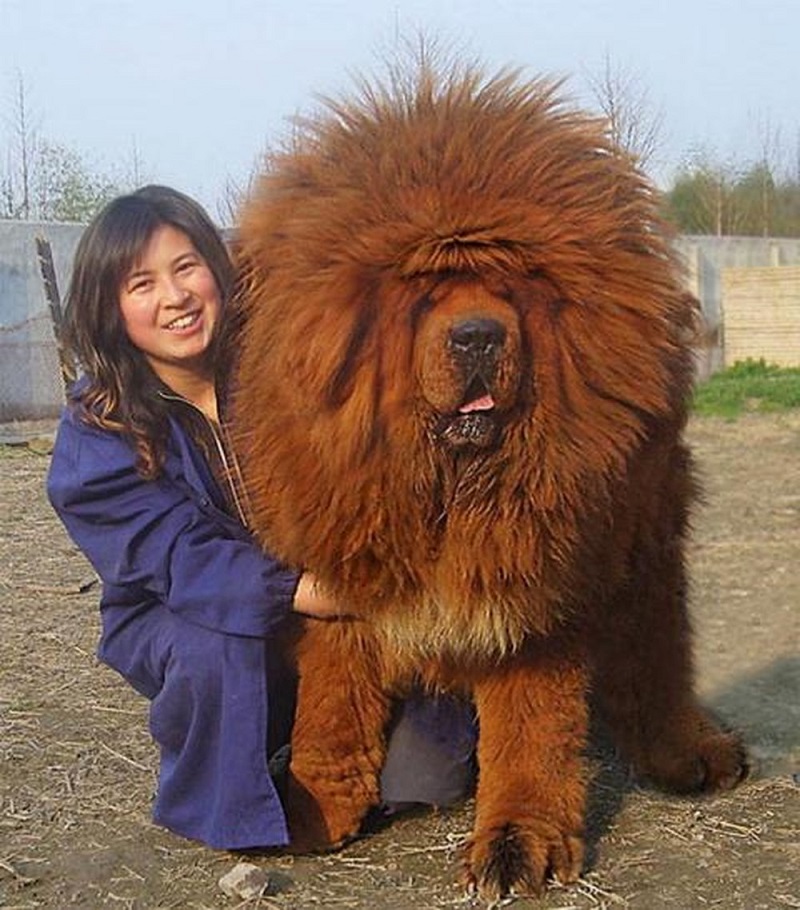In the realm of canines, few breeds can match the awe-inspiring presence and regal demeanor of the Tibetan Mastiff. With a history stretching back thousands of years, this ancient breed has long been revered for its strength, courage, and unwavering loyalty. In this comprehensive guide, we will delve into the distinctive characteristics, behavior, and proper care of the Tibetan Mastiff. Additionally, we will explore the factors that influence their value and provide insights into training and socialization techniques that can help these majestic creatures thrive.

Distinctive Characteristics of the Tibetan Mastiff
Unveiling the unique features of the Tibetan Mastiff is essential in understanding the breed’s nature and needs. From their striking appearance to their powerful physique, here are the distinctive characteristics that make the Tibetan Mastiff stand out among other dog breeds.
Striking Appearance
Tibetan Mastiffs are immediately recognizable due to their massive size, thick double coats, and intimidating presence. Males can reach heights of up to 30 inches at the shoulder and weigh over 150 pounds, while females are slightly smaller. Their coats come in various colors, including black, red, and golden, and serve as a shield against harsh weather conditions.
Their large heads are adorned with expressive eyes and a distinctive black mask, contributing to their noble appearance. Their ears are also set high on their head and drop down, adding to their majestic look. Overall, the Tibetan Mastiff exudes an air of power and grace, making them a sight to behold.
Powerful Physique
Beneath their thick coats lies a body of immense strength and agility. Tibetan Mastiffs possess broad chests, muscular limbs, and sturdy bones, allowing them to navigate rugged terrain and protect their territory with ease. Their strong jaws and sharp teeth make them formidable guardians, capable of taking down predators and intruders.
Their physical prowess also makes them excellent working dogs, used for tasks such as herding and guarding livestock. However, it is essential to note that their size and strength require proper training and handling to prevent any accidents or injuries.
Loyal and Protective Nature
One of the most notable characteristics of the Tibetan Mastiff is their unwavering loyalty and protective nature. Bred to guard and protect, these dogs take their role seriously and will do whatever it takes to keep their family safe. They are fiercely devoted to their owners and will form strong bonds with them, making them excellent companions.
However, this loyalty and protectiveness can also manifest in aggression towards strangers or other animals. Early socialization and training are crucial in ensuring that the Tibetan Mastiff learns to differentiate between potential threats and harmless individuals.
Unveiling the Tibetan Mastiff’s Behavior

Understanding the behavior of the Tibetan Mastiff is vital in providing them with the proper care and training they need. Here are some common behaviors exhibited by this breed:
Independent Nature
Tibetan Mastiffs have a strong independent streak, which can make them challenging to train at times. They were bred to work independently and make decisions on their own, which can lead to stubbornness and a lack of obedience. It is crucial to establish yourself as the leader and use positive reinforcement techniques to train your Tibetan Mastiff effectively.
Moderate Energy Levels
Despite their large size, Tibetan Mastiffs are not overly energetic dogs. They require daily exercise but are content with moderate activity levels. A walk or playtime in the yard is usually enough to keep them physically and mentally stimulated. However, they do enjoy activities that tap into their natural instincts, such as hiking or tracking games.
Low Barking Tendency
Contrary to popular belief, Tibetan Mastiffs are not excessive barkers. They are known for their calm and quiet demeanor, only barking when necessary. This trait makes them suitable for apartment living, as long as they receive enough exercise and mental stimulation.
Essential Guide to Raising a Tibetan Mastiff
Raising a Tibetan Mastiff requires dedication, patience, and proper knowledge of the breed’s needs. Here are some essential tips for ensuring your Tibetan Mastiff thrives under your care:
Proper Nutrition
As with any dog breed, providing your Tibetan Mastiff with a balanced and nutritious diet is crucial for their overall health and well-being. Due to their large size and energy levels, they require a high-quality diet that is rich in protein and nutrients. Consult with your veterinarian to determine the best diet plan for your Tibetan Mastiff based on their age, activity level, and any health concerns.
Grooming Needs
The thick double coat of the Tibetan Mastiff requires regular grooming to keep it healthy and free from mats and tangles. They shed heavily twice a year, requiring more frequent brushing during these periods. Additionally, their nails should be trimmed regularly, and their ears and teeth should be cleaned to prevent any infections.
Socialization and Training
Early socialization and training are crucial for the Tibetan Mastiff to develop into well-adjusted and well-behaved dogs. Introduce them to different people, animals, and environments from a young age to help them become comfortable and confident in various situations. Positive reinforcement techniques work best with this breed, as they respond well to praise and treats.
Factors Influencing the Price of a Tibetan Mastiff

Tibetan Mastiffs are known for being one of the most expensive dog breeds in the world, with some individuals selling for millions of dollars. However, several factors influence the price of a Tibetan Mastiff, including:
Bloodline and Pedigree
The bloodline and pedigree of a Tibetan Mastiff play a significant role in determining its value. Dogs from champion bloodlines or with a long line of prestigious ancestors can fetch a higher price due to their perceived superior genetics.
Physical Characteristics
As with any breed, the physical characteristics of a Tibetan Mastiff can impact its value. Dogs that conform to the breed standard and possess desirable traits such as a large head, thick coat, and strong physique are more likely to command a higher price.
Rarity
Tibetan Mastiffs are not a common breed, and finding a reputable breeder can be challenging. This rarity factor can drive up the price of these dogs, especially if they are in high demand.
Location
The location of the breeder or seller can also influence the price of a Tibetan Mastiff. In areas where the breed is scarce, the cost may be higher due to the limited availability. Additionally, transportation costs may also add to the overall price if the dog needs to be shipped to a different location.
Training and Socialization Techniques for Tibetan Mastiffs
Proper training and socialization are crucial for the well-being and behavior of Tibetan Mastiffs. Here are some tips to help you train and socialize your Tibetan Mastiff effectively:
Start Early
Early training and socialization are essential for this breed, as they tend to become more stubborn and independent as they grow older. Start training your Tibetan Mastiff from a young age, and expose them to different people, animals, and environments to help them develop into well-rounded dogs.
Use Positive Reinforcement
Tibetan Mastiffs respond best to positive reinforcement techniques, such as praise and treats. Harsh methods or punishment can lead to fear and aggression in this breed, so it is crucial to use gentle and consistent training methods.
Be Patient and Consistent
Training a Tibetan Mastiff requires patience and consistency. These dogs can be stubborn at times, but with patience and consistent training, they can learn to follow commands and behave appropriately.

Preserving the Legacy of the Tibetan Mastiff
The Tibetan Mastiff is not just a breed; it is a part of history and culture. However, due to their increasing popularity and high demand, the breed has faced several challenges, including overbreeding and unethical breeding practices. As responsible dog owners, it is our duty to preserve the legacy of this majestic breed by:
Choosing Reputable Breeders
When looking to add a Tibetan Mastiff to your family, it is crucial to do thorough research and choose a reputable breeder. A responsible breeder will prioritize the health and well-being of their dogs and will not engage in unethical practices such as overbreeding or inbreeding.
Educating Others
Educating others about the breed’s needs and characteristics can help prevent misunderstandings and misconceptions about Tibetan Mastiffs. This, in turn, can help reduce the number of dogs that end up in shelters due to improper care or behavior issues.
Supporting Rescue Organizations
Unfortunately, some Tibetan Mastiffs end up in shelters or rescue organizations due to various reasons. Supporting these organizations through donations or volunteering can help provide a better life for these dogs and raise awareness about the breed.
Conclusion
In conclusion, the Tibetan Mastiff is a majestic and unique breed with distinctive characteristics and behaviors. Proper care, training, and socialization are essential in ensuring that these dogs thrive and fulfill their role as loyal and protective guardians. While their price may be high, their value as companions and working dogs is immeasurable. By understanding and preserving the legacy of the Tibetan Mastiff, we can continue to appreciate and admire this ancient breed for generations to come.
